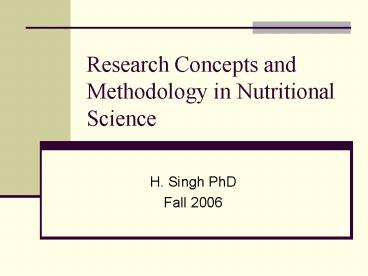Research Concepts and Methodology in Nutritional Science - PowerPoint PPT Presentation
1 / 24
Title:
Research Concepts and Methodology in Nutritional Science
Description:
Chinese or eastern culture, ideas belong to culture and society. In west writing is visible, concrete demonstration of knowledge insight and ... – PowerPoint PPT presentation
Number of Views:81
Avg rating:3.0/5.0
Title: Research Concepts and Methodology in Nutritional Science
1
Research Concepts and Methodology in Nutritional
Science
- H. Singh PhD
- Fall 2006
2
NTRS 511
- Syllabus
- Website www.calstatela.edu/faculty/hsingh2
- Timing 420 -6.00pm
- 610 - 1000pm
- What are we going to do? learn what is involved
in research. - Different issues and steps involved in research
- A project and research thesis
- Research proposal
3
Syllabus contd. What are you going to work on?
- You will select a topic for research and justify
it on the basis of present data available - Find a review article and present - 10
- Take home Midterm to critically analyze an
research article from your topic with instructors
consent ---- 20 - SPSS Workshop ----- 20
- Group discussion, submitting the suggestions and
reviewing others proposal - 10 10
4
Steps of Research
- Problem
- Hypothesis
- Factors
- Experiment
- Collect Data
- Analyze data
- Conclusion
5
Syllabus contd.
- Final paper presentation after taking care of all
the comments 15 - Final proposal submission 15
- using NIH guidelines
6
- SPSS workshop
- http//www.calstatela.edu/its/training/sstp/
- timing
- Pick up very interesting topics
- I will be here and will help you at every stage
- You are suppose to read and work yourself and
meet the deadlines
7
Presentations
- For Review articles
- General Introduction to the concept.
- What scientists have found in last five to ten
years? - What is gap area and how you intend to solve it?
- Generally
- Clearly define the topic
- Background - What has been done
- What methodology was used
- Clear
- Audible
- Interactive
- Fonts, color combination and flow
8
Library Search and Plagiarism
- H. Singh
9
What is Research?
- To answer a question
- To apply a new idea
- To check a hypothesis
- But sometime we
- copy ideas plagiarism is a big problem
- Let us discuss this in a bit detail why people do
it ----
10
Plagiarism
- What is plagiarism?
- Difference in west and east
- In West ideas can be owned
- Chinese or eastern culture, ideas belong to
culture and society - In west writing is visible, concrete
demonstration of knowledge insight and academic
skills so you cannot represent or use others
writing
11
CSULA Plagiarism policy
- Plagiarism is direct violations of intellectual
and academic honesty - Plagiarism refer to representing somebody elses
words or ideas as ones own - Most extreme form of plagiarism is copying paras
or lines from a paper - Citation should be done
- May end up failure, probation, suspension or
expulsion. - SO BE CAREFULL
12
Type I plagiarism
- Turning on someone elses paper
- Why students do it?
- Lazy
- Do not manage there time well
- Do not know how to do it but do not ask for help
- Language problem but avoid getting a bad grade
13
Where do students get paper
- Internet
- Buy from research services
- Friend taken course before
- Copy materials
14
Why it is wrong?
- Undermines the entire educational system
- Learning is important
15
Will you get caught?
- Instructor feel insulted and uncomfortable
- If suspected it is easy to find the source
- Instructor has lots of experience
- In reality the work is clumsy and obvious
- Forget to change the gender
- Copying the samples
- Unable to answer any question
- www.turnitin.com
- http//www.calstatela.edu/academic/aa/ess/elps/tur
nitin/Recommendations.htm
16
Solution
- Manage your time
- Ask for help
17
Types II Plagiarism
- Assembling the article from other text
- Can be caught from the style clash
- no original wording
- but is this wrong
- it should be presented in quotes and cite the
source - It is still not acceptable
18
Type III plagiarism
- Writing information in your own words
- Understand the information very well
- Mostly just try to substitute some words
- Changes and reorganization is step in the right
direction - Getting familiar with the concepts and subject
matter happens with time and writing skills
improve
19
Avoid plagiarism
- Document sources
- Note concepts on cards
- Understand concepts
- Write in your own words
- Organizing and writing in own word is most
challenging - Can only be mastered with practice
20
How to Cite
- Modern Language Association (MLA)
- American Psychological Association (APA)
- Many other
21
Other important starting point
- Literature review to find what has been done
- Where to go and what to find?
- Traditional ways were going to the library and
spend days in there - Chemical abstracts
- Biological abstracts
- Note down the references and look for the
journals - But now it has changed and is very easy -
22
Library Search
- CSU LA web site
- Google Scholar
- Pub Med
- Medline
23
Library Search
- http//www.calstatela.edu/library/tutorial/new/map
.htm - http//www.aaccnet.org/cerealchemistry/default.asp
- http//www.pubmedcentral.nih.gov/
- http//www.nlm.nih.gov/
- http//scholar.google.com/
- www.ift.org
- www.fda.gov
24
Finding a review article
- Review articles are published as apart of regular
journals - Or there are specialized journals publishing
reviews - These are peer reviewed
- News paper articles or Web pages are not
- Where to find
- Look for critical review journals
- http//www.calstatela.edu/library/opac/periodicals
.html































